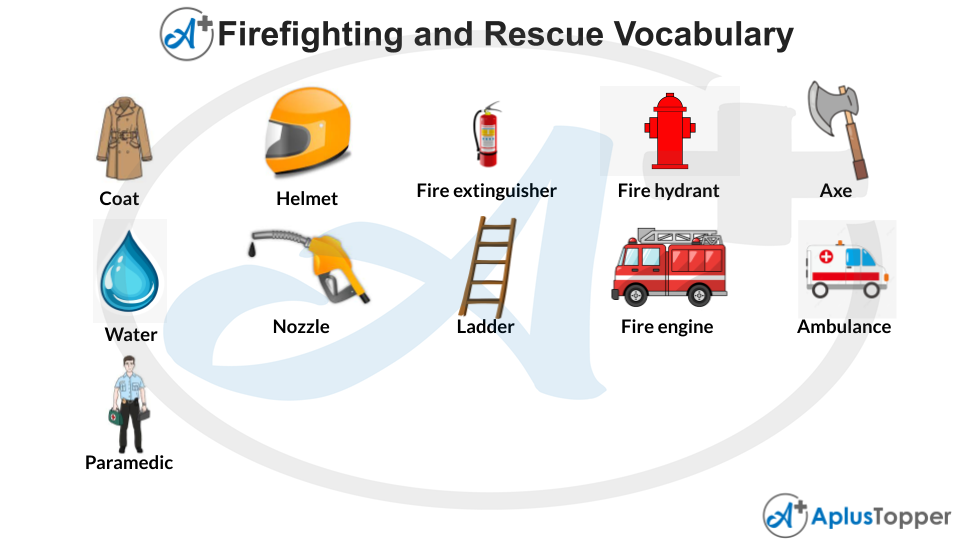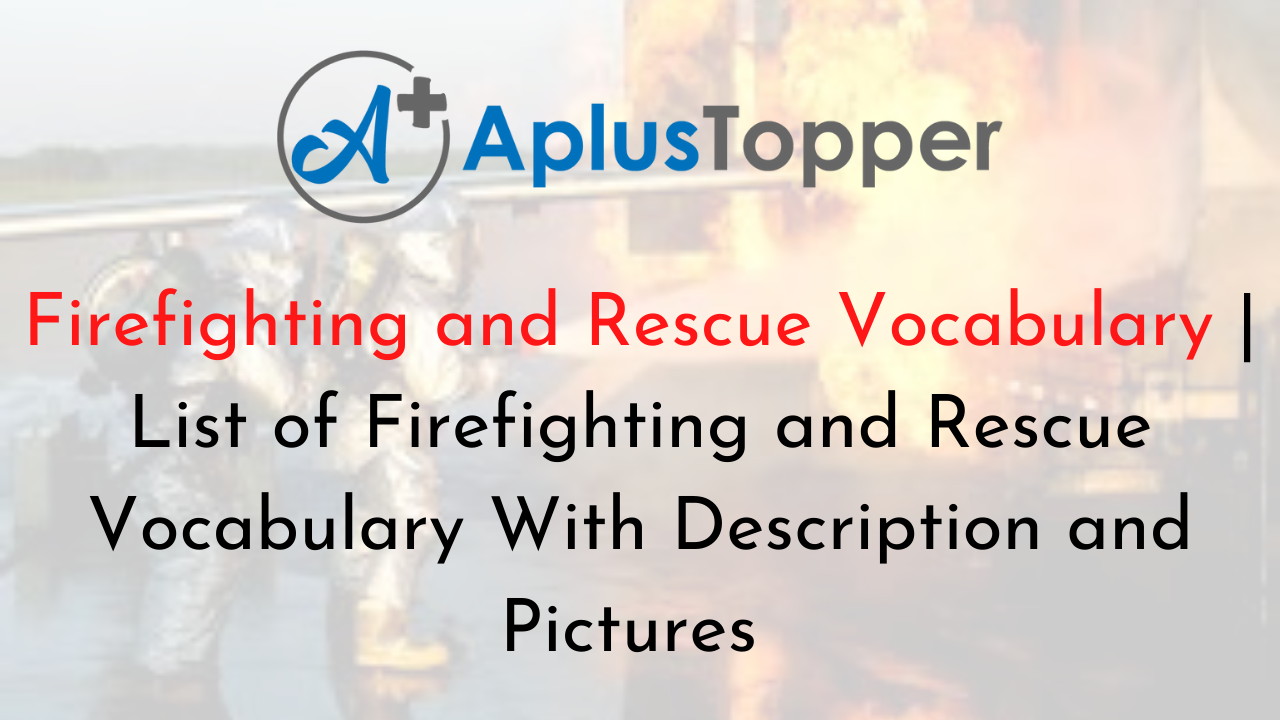Firefighting and Rescue Vocabulary: Fire is a good slave but a terrible master, as the old adage goes. It can be devastating if it is not within complete control or if it arises out of nowhere. Although fire vocabulary words may seem enthralling, fire, in reality, is not magnificent at all.
There are numerous methods for putting out a house fire. There is no need to blind panic and simply rely on the firefighters and be aware of fire vocabulary word list in the eventuality of a catastrophe. We’ve put together a list of Firefighting and Rescue vocabulary for you.
List of Firefighting and Rescue Vocabulary Words in English
- Name of Firefighting and Rescue Vocabulary words
- Description of the Firefighting and Rescue Vocabulary words.
Name of Firefighting and Rescue Vocabulary Words
This article contains useful information on fire terms and definitions that can help enormously when you need to communicate directly in a crisis.
This handpicked set of firefighter vocabulary is intended to assist you in becoming more conscious of firefighting emergencies and preparing you for the worst-case eventuality.
List of tools of the Firefighting and Rescue
- Coat
- Air tank
- Helmet
- Set of Irons
- Fire extinguisher
- Ceiling hook
- Fire hydrant
- Barricade
- Axe
- Smoke alarm
- Water
- Hydrant Wrench
- Nozzle
- Air mask
- Sprinkler system
- Ladder
- K-tool
- Fire engine
- Flashlight
- Pike Pole
- Ambulance
- Carabiner
- Paramedic
- Escape route

Description of the Firefighting and Rescue Vocabulary Words
Coat
The majority of the coats are composed of fire-resistant materials. They protect firefighters from fire burns and other potentially dangerous conditions.
Air tank
The amount of pressure in fire pumps is consistently maintained by an air tank. The volume of the air vessel tank is influenced by the external pressure of the fire pump.
Helmet
Helmets are donned by the firefighters to safeguard them from the extreme heat, cinders, and constantly falling items. Helmets should have a protective shell, an energy absorption mechanism, a retention framework, reflective finish, ear coverings, a face shield, safety goggles, or even both.
Set of Irons
Simply The Irons is formed by combining a Halligan bar and a flathead axe that have been coupled together (and somewhat interlaced, head-to-toe). Within the emergency response team, this combination of tools is very widespread.
Fire extinguisher
Transportable fire extinguishers have been used to put out small smoke and flames or mitigate the devastation they cause before firefighters arrive. These are retained on standby in settings like fire stations, buildings, workplaces, public transit, etc.
Ceiling hook
The ceiling hook is one of the most flexible and adaptable hooks in today’s fire and rescue service. This hook can be deployed to effectively eliminate wood, carpet padding and plaster, tin and sheet metal, plasterboard, fiberboard, and gypsum from walls and ceiling, partitions, floors, moldings, and casings.
Fire hydrant
Fire hydrants, also known as active fire protection equipment, essentially allow firefighters to immediately identify the appropriate supply of water at a fire site. The storage tank of a fire engine only holds adequate water to put out the blazing fire in the first place before hoses are coupled to suitable fire hydrants.
Barricade
A barricade is an obstacle or barrier used to regulate and control or impede movement through an area where a fire has erupted.
Axe
A fire axe is a model of an axe that has been designed solely for use by firemen, and it has numerous characteristics that make it appropriate for crisis services in the first place.
Smoke alarm
A smoke detector automatically detects intense smoke in the vicinity where it is positioned. The detector notifies residents of an exceptionally high percentage of smoke in the area.
This minimizes the likelihood of the fire propagating and causing injury to individuals. The dependable detector is attached to a smoke alarm that sounds to alert all-around people.
Water
Water is always the first option on the table that immediately springs to mind.
When it comes to putting out a fire, water is vital.
Hydrant Wrench
A hydrant wrench is a tool for dismantling fire hydrant caps and adjusting the hydrant’s valve. They’re commonly flexible to fit various hydrant nut sizes.
Nozzle
One of the most widely utilized components of firefighting equipment is the nozzle. Fire nozzles could either give a continuous stream or enable firefighters to determine the optimum flow velocity and operating parameters for their firefighting requirements. A fire nozzle is a piece of machinery that attaches to a fire hose and sprays water or fire fighting foam to put out the flames.
Air mask
The air mask safeguards firefighters’ faces from intense heat, smoke and flames, dust, and flying debris while effectively allowing them to view properly.
Sprinkler system
Water is utilized in fire sprinkler systems to suppress or regulate smoke and flames and prevent the rapid spread of fire until firefighters arrive on the scene.
Ladder
The ladder allows firefighters to access higher ground and assist in extinguishing fires and the emergency evacuation of people trapped in high-rise structures.
K-tool
The K-Tool is lightweight and compact, making it a good choice for simply carrying a coat pocket or pouch. It was also the first factory-made equipment for firefighters to pull lock cylinders, along with its parts.
Fire engine
The basic fire engine transport firefighters to the location, distribute a limited amount of water to douse the flames, and conveys the equipment required by firefighters in most firefighting scenarios. A typical structural engine contains 400-500 gallons of water and tackles a fire with a constant stream of water to cool it down.
Flashlight
A firefighter flashlight is engineered to provide adequate light for firefighting duties. It’s a gadget composed of tough materials that can endure the most extreme situations.
Pike Pole
A Pike Pole is regarded as one of the most multipurpose tools available to a firefighter.
A pike pole is a firefighting instrument that firemen use to knock down drywall. Firefighting pike poles nowadays vary in length from 4 to 12 feet and are constructed of an array of materials, including stainless steel, fiberglass, and infrequently wood.
Ambulance
An ambulance is always necessary to arrive at the scene. This is to ensure that anyone trapped within receives rapid assistance when they are evacuated. It also serves as the first line of defense for any injured individuals on the site.
Carabiner
For firemen, carabiners are a piece of must-have equipment. Every fireman should have one in their coat pocket or pre-rigged to their safety harness because of how flexible and adaptable they are with their many widespread applications.
Paramedic
Firefighter paramedics are firefighters who have received substantial paramedic schooling. They’ll be prepared to support with a variety of medical and case emergencies scenarios.
Escape route
The escape route is the best way to get out safely and securely. The whole exit route from a property, up to and including the final exit, must be absolutely clear at any and all circumstances, and the length people must traverse to escape has to be as minimal as possible.
